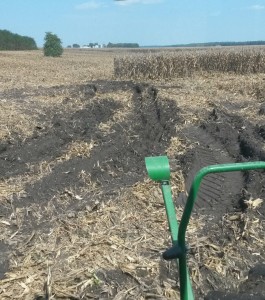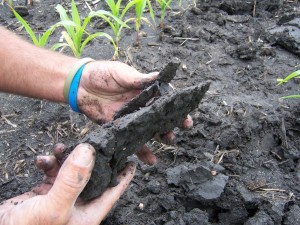Bob Kassing, owner of Kassing Farms in West Central Illinois, learned decades ago the advantages of drainage tile. You would be hard-pressed to find a field in the operation that isn’t tiled to some degree.

Within the last five years the Kassing family – a corn, soybean and cattle operation – began to embrace the benefits of pattern tiling or system drainage. Ag Drainage Inc. (ADI) installed two pattern tiling systems for Kassing including a 34 acre field this fall. With this year’s unusually wet conditions, Kassing is glad they did.
“Just about all our fields have been tiled, at least in the draws and seeps,” Kassing said. “But when you have a year like this with record rains those tiled places are okay, but it’s everything in between that’s the problem. There’s no way the random tile can begin to keep up.”
The impacts of this wet harvest will last well beyond this growing season. Some of the most obvious effects are the areas of compaction caused by equipment and trucks sinking into the wet ground which will disrupt planting efficiency and crop productivity in the spring. When soil is too compact, plant roots are unable to penetrate the ground and obtain vital nutrients.
An article published by the University of Minnesota Extension outlines several negative effects from excessive compaction including damaged soil structure, reductions in nutrient uptakes and decreased crop yields.
“When structure and pore space are reduced there is less air and moisture in the soil. This condition negatively influences all phases of crop production including seed germination; seedling emergence; root growth; and nutrient and water uptake,” according to the article.
Tires, Traction and Compaction by Jodi DeJong- Hughes compiles more than 10 studies about the impacts of compaction on crop production. The studies, conducted largely in the Midwest, document how damaging compaction can be, causing decreases in yields anywhere from two years all the way up to 12 years in some cases.

In one instance reported in 2000, Purdue University researchers found stand count reductions of 20 to 30% in the compacted plots, and corn yields were 160 bushels per acre in non-compacted soil compared to only 130 bushels in compacted plots.
Going beyond the soil structure and plant production, compaction has also been shown to increase the overall energy required to prepare the field for planting.
“In an experiment in Illinois, the energy requirements to prepare a seedbed were measured in a compacted and noncompacted soil,” DeJong-Hughes wrote. “The compacted soil caused a 10 to 16 fold increase in energy required at low speeds and a 4 to 8 fold increase at high speeds.”
Both DeJong-Hughes and Bob Kassing came to the same conclusion: the best way to reduce compaction is to prevent it by not driving across fields that are too wet.
“Pattern drained fields were the first ones I could get on in the spring and the ones I went to first when we were hoping to start harvest,” according to Kassing. “You still have to use common sense, but it gives you a feeling of security to know you’re going to be able to go to a field and not bury your combine.”
The full article by DeJong-Hughes is available online at: www.extension.umn.edu
